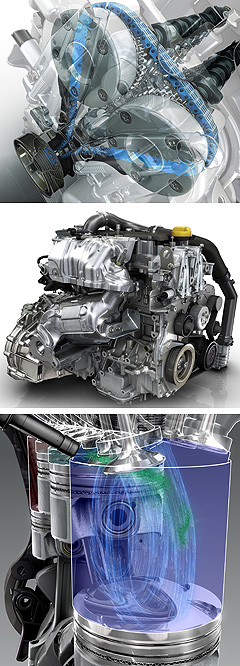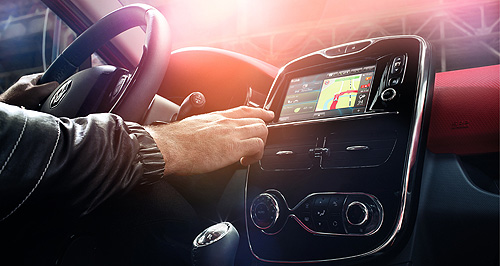Make / Model Search
News - RenaultGeneva show: Renault Oz to offer in-car internetFrench connection: Renault’s R-Link infotainment system enables the driver to access email, social networking and other internet services from their car. Latest Renault R-Link infotainment tech showcased at Geneva, headed for Australia6 Mar 2013 By HAITHAM RAZAGUI in GENEVA RENAULT will offer a comprehensive range of in-car online services on its cars in Australia through the new R-Link infotainment system, starting with the new Clio that arrives in October. The R-Link system accesses the internet via the data connection of a smartphone tethered using Bluetooth to deliver online services such as e-mail, Twitter, weather reports, news headlines and petrol prices through the seven-inch touchscreen. It is similar to the General Motors MyLink technology fitted to the Holden Barina CDX, facelifted Cruze and upcoming VF Commodore. Renault Australia managing director Justin Hocevar told GoAuto the system will be available in Australia and priced at an attainable level that “democratises” a technology once reserved for high-end luxury vehicles. He said Renault’s global third-party provider of R-Link services is telecommunications group Orange, and this company is being engaged to deliver the Australian infrastructure.  Left: The new Renault TCe 130 petrol engine. Left: The new Renault TCe 130 petrol engine.Premium subscription services available in Europe include TomTom Live, which integrates with the sat-nav feature to provide real-time traffic updates, warn of traffic hazards, provide accurate arrival times based on traffic flow data and an expanded, continuously updated points of interest database. Another subscription system called Coyote is like an automotive social network that enables drivers to share validated, up-to-date information about road conditions such as delays, hazards and speed cameras. For safety reasons some features cannot be used or have limited abilities while the vehicle is in motion, one example being email. A text-to-speech function reads out received emails while on the move, with the full facility – with similar cut-down features as found on a smartphone – enabled once parked. The R-Link Tweet app only works when stationary and enables occupants to login to their Twitter account, read and forward tweets and comments, view lists of followers and keep up with users being followed. Other apps include weather, news, events, tourist information, Yellow Pages and the price of fuel at nearby petrol stations. Interactive vehicle service manuals and service logbooks can be accessed via R-Link and the Renault Assistance app enables the driver to contact Renault in case of an accident or breakdown, providing the call centre with the vehicle’s identification number and GPS location. More frivolous apps are available, one being R-Sound, which enables the driver to select the engine note of various Renault cars – including race cars – to be accurately synthesised through the audio system by analysing the car’s real engine speed, accelerator pedal position and road speed. Further apps can be downloaded from the R-Link Store, where 50 titles were available at the time of launch. R-Link also includes a coaching system to encourage drivers to adopt a fuel-saving driving style, even comparing similar journeys to track progress and provide feedback. The system is also adapted for electric vehicles to track energy consumption, calculate whether the vehicle has enough battery range to complete a journey programmed into the sat-nav and suggest routes that will use less energy. EV users can access their car via smartphone or computer to check battery status, pre-plot routes depending on recharging locations, set the car’s cabin temperature before a journey and set charging timers to take advantage of cheaper off-peak energy. Renault’s lauded Energy engine range was officially expanded at Geneva with the arrival of the TCe 130 turbo-petrol unit producing 97kW of power and 205Nm of torque while consuming up to 20 per cent less fuel than the engines of similar performance it replaces. That equates to 5.4 litres per 100 kilometres on the Megane hatch, an improvement of more than 1.0L/100km, with CO2 emissions down 29 grams per kilometre to 124g/km. However Mr Hocevar said the new engine is not yet scheduled for inclusion in the Australian line-up. In markets where the engine is available, drivers stand to save more than just fuel, as the Energy TCe 130 has service intervals of 30,000km and a timing chain designed to last the life of the engine. Despite displacing just 1.2 litres Renault says the engine offers the performance of a naturally aspirated 2.0-litre unit and that the drivetrain has benefited from the company’s Formula 1 experience, with technologies such as diamond-like coatings on the cam followers and graphite-coated piston skirts. Peak power is developed at 5000rpm and maximum torque is available between 2000rpm and 3000rpm, with 90 per cent available from 1500rpm. Renault says this, in addition to its refinement and operation that is up to 50 per cent quieter than its predecessor, makes the TCe 130 a “pleasure to drive”, with a “crisp response from low revs” and “outstanding flexibility”. In addition to regenerative braking and an “ultra-rapid” idle-stop system that detects the position of each piston and injects fuel to the cylinder best placed to restart the engine quickest, the TCe 130 employs carefully designed intake and turbo plumbing, direct fuel injection, low pressure exhaust gas recirculation, variable displacement oil pumps and efficient thermal management to achieve fuel efficiency.  |
Click to shareRenault articlesResearch Renault Motor industry news |









Facebook Twitter Instagram